Notes: Shortly after the introduction of the rail-motor service in 1906 a halt was opened at The Hale for Mill Hill on 11 June 1906 in an attempt to attract more passenger revenue. The halt, which consisted of a timber platform on the up side of the line, was sited close to the Midland Railway's Mill Hill (Mill Hill Broadway from 1950) to allow easy interchange between the two lines.
As built the station had no booking office or waiting shelter and was lit by gas lamps at the back of the platform. Wooden steps led down to the platform from Bunns Lane. In 1910 a timber booking office and waiting room were added at the west end of the platform.
 |
Goods services were provided from 18 July 1910, but the goods yard was 600yd south-east of the passenger station and comprised two sidings on the up side of the line. In 1926 further sidings were added to handle building materials for new residential development in the area. On 1 March 1928 the halt was renamed Mill Hill for The Hale. |
As part of the ‘New Works Plan’ the station was to be come an important interchange station known as Mill Hill (The Hale) with a new footbridge from the LMS station to provide better interchange facilities. The service was suspended on 11 September 1939 to allow the work to be completed.
By the outbreak of war in 1939 a second track, complete with conductor rail, had been laid as far as The Hale, and a second platform had been built there. At that time the original timber platform was still in place but it was extended in concrete beneath Bunns Lane bridge. The new down platform extended for 50yd beyond the bridge.
During this period the booking office remained open for the sale of tickets which could be used on the replacement bus service. In order to save money the booking office was closed from 18 May 1941 and ticket stocks were transferred to the LMS station where they remained on sale until the late 1960s for use on the 240 bus which took on the role of the |
 |
replacement bus service.
The second track was lifted in 1941 and the original line, which was still open for goods traffic, was realigned away from the timber platform. Although London Transport intended to continue with the New Works Plan after the war no progress was made, and the extension was officially abandoned in February 1954.
By 1958 the timber platform and station buildings had been demolished leaving just the concrete extension under Bunns Lane bridge.
 There are many published maps showing the Northern Line extensions, and not all of them get it right. This map shows the original Mill Hill (The Hale) station with a new Northern Line station symbol alongside. The other Mill Hill (now Mill Hill Broadway) is seen on the other line, to the north.
There are many published maps showing the Northern Line extensions, and not all of them get it right. This map shows the original Mill Hill (The Hale) station with a new Northern Line station symbol alongside. The other Mill Hill (now Mill Hill Broadway) is seen on the other line, to the north. |
The goods yard closed on 29 February 1964 and the track was lifted through the station by the end of that year. The east end of the station site was buried under construction debris from the M1 motorway in the early 1970s, but a section of the down platform under the bridge could still be seen until the mid 1990s when the bridge arches were bricked up during the construction of a new residential development on the east side of the bridge.
A 50yd section of the down platform can still be seen, although now heavily overgrown, to the west of the bridge. This can easily be observed by descending into Lyndhurst Park from Bunns Lane. A short section of the former line runs along the north side of the park. |
BRIEF HISTORY OF THE FINCHLEY - EDGWARE LINE
The Edgware, Highgate & London Railway obtained an Act in 1862 to build an 8¾-mile line from a junction with the GNR at Seven Sisters Road (renamed Finsbury Park on 5 November 1869) to a terminus at Edgware. The GNR agreed to work the line, providing staff and rolling stock in return for 50% of the gross receipts.
The following year, the Midland Railway received authority to build a line between Bedford and St Pancras which would provide a quicker route into central London from the Mill Hill area. To improve the prospects of their Edgware line, the EH & LR proposed a branch from Highgate to Muswell Hill serving the new Alexandra Palace leisure complex and an 6¾- mile extension of their main line from Edgware to Watford.
Both proposals were approved by Parliament in 1864, as was a further branch from Finchley to High Barnet in 1866.
 |
The main line between Seven Sisters Road and Edgware proved more costly than expected with tunnelling required at Highgate and a high viaduct taking it over the Dollis Brook. The local company was soon in financial difficulty and, shortly before completion, the EH & LR was taken over by the Great Northern who opened the line on 22 August 1867 |
with intermediate stations at Crouch End, Highgate, East Finchley, Finchley & Hendon (renamed Finchley on 1 February 1872, Finchley [Church End] on 1 February 1894 and, finally, Finchley Central on 1 April 1940) and Mill Hill (renamed Mill Hill East for Mill Hill Barracks from 1 March 1928). Although Edgware was built as a through station with two platforms the extension to Watford was never built as the GNR were not convinced it would generate sufficient revenue.
The new line was double-track between Seven Sisters Road and Highgate and single-track beyond Highgate, with passing loops at Finchley & Hendon. It was assumed that the north end of the line would be doubled at a later date so some structures, including the viaduct over the Dollis Brook, were built to a width that would accommodate a second track.
There were 18 daily workings in each direction, although eight of these ran only between Seven Sisters Road and Highgate.
The line was doubled between Highgate and East Finchley on 1 December 1867 and to Finchley & Hendon on 1 November 1869, prior to the opening of the High Barnet branch on 1 April 1872. To accommodate the extra traffic expected to be generated by this branch, Finchley & Hendon was rebuilt with an additional platform face which allowed services that had previously terminated at Highgate to be extended.
With the opening of High Barnet the service was improved, with 24 trains in each direction to central London. The majority of these trains ran from High Barnet with only one through service in each direction between central London and Edgware, and a shuttle operating between Edgware and Finchley, where passengers for London had to change.
The junction with the Edgware line made through running difficult as there was no direct connection between the down line and the original single track. It was reconfigured in June 1896 which allowed more through services to run to Edgware, but there were never more than six in each direction.
In an attempt to reduce running costs two GNR steam rail-motors, built to a design of H.A.Ivatt, were brought in to operate the shuttle service between Edgware and Finchley on 19 February 1906. The rail-motors brought little improvement to passenger revenue with only an additional £9 in passenger receipts in March 1906 and earnings per car of 5d per mile, while running |
 |
costs were 7d.
In an attempt to generate additional income, a halt was opened at The Hale on 11 June 1906. It was conveniently sited close the Midland Railway's Mill Hill (today known as Mill Hill Broadway) station, enabling easy interchange.
The rail-motors proved unpopular with passengers as they gave a rough ride with continuous vibration. Within a few months they were withdrawn and replaced with conventional steam traction. Rail-motors were once again tried in September 1929. This time a 59-seat Sentinel, The Rising Sun, was used, but it proved as unpopular as its predecessors and was withdrawn the following year.
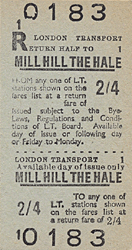 |
In 1935 the London Passenger Transport Board announced their 'New Works Plan' which included a proposal to take over the ex-GNR line between Finsbury Park and Edgware / High Barnet and the Alexandra Palace branch. The plan included the doubling and electrification of the Edgware line with improvements to the stations including a second platform at Mill Hill East and The Hale. The GNR station at Edgware would close to passengers with trains being diverted into the Underground station which had opened on 18 August 1924 as the terminus of the second phase of the Underground Group's extension of the Charing Cross, Euston & Hampstead Railway from Golders Green. The ‘underground’ station – actually on the surface - would be enlarged and rebuilt as a through station with the line extended northwards to Bushey Heath, utilising part of the route of the EH & LR extension to Watford which had not been built. |
All of these lines would be incorporated into the Northern Line, and a new connection with the Northern City line at Finsbury Park would provide a fast and frequent service of electric trains into central London.
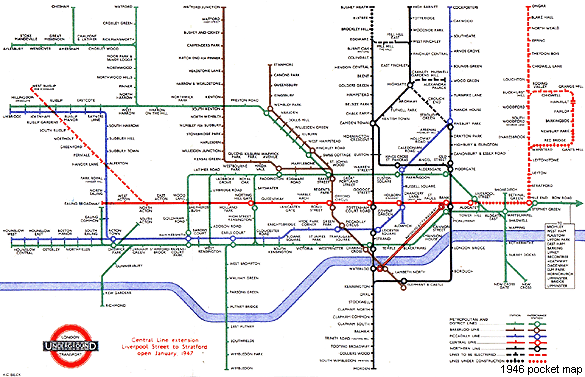 |
The New Works Plan was adopted, and work on the electrification and new infrastructure started alongside the steam service which continued to operate. On the Edgware line this was still largely a shuttle service with running intervals of between 30 and 50 minutes. There was now only one through service departing from Edgware at 7.52 am.
Work on the electrification and track doubling started in 1938. The service on the Edgware line was suspended on some Sundays, and on 3 July 1939 the existing Northern Line service was extended from Archway to East Finchley where it surfaced alongside the LNER line from Finsbury Park, just south of the station. The service on the Edgware line was suspended completely from 11 September 1939 to allow the work to be completed. The stations remained open for the sale of tickets which could be used on replacement buses. The New Works Plan was expected to be completed with all lines open by spring 1941. All the new lines were shown as 'under construction' on LPTB pocket maps from 1938 onwards.
 |
By the outbreak of war in 1939 work to integrate the Edgware line into the Northern Line was progressing well. A second track, complete with conductor rail, had been laid as far as The Hale, and a second platform had been built there. Lineside cabling had also been installed, and sub-stations built at Edgware and at Page Street (between Mill Hill and the Hale). At Edgware a plate girder bridge was built to carry northbound traffic over the Northern line and on towards Bushey Heath. The Northern Line station at Edgware had been remodelled to accommodate the additional service with new platforms partly built and a new signal box completed.
With the outbreak of war, some work continued north of Highgate on both the Edgware and High Barnet lines. Most work stopped in September 1940 with the start of the Blitz, with the exception of the line between Finchley and Mill Hill East because of the strategic importance of nearby Inglis Barracks - home to the Middlesex Regiment. Mill Hill East re-opened with |
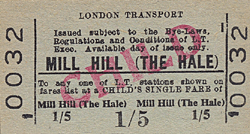 |
tube trains on 18 May 1941. At the same time the replacement buses were withdrawn and were replaced by extending the existing 240 route from Mill Hill Broadway to Mill Hill East.
After 1941 the various unfinished Northern Line extensions were removed from subsequent Underground maps, although they reappeared between 1946 and 1949.
London Transport had every intention of completing their New Works after the war, hoping to finish the line between Mill Hill East and Edgware in 1948 with the extension to Bushey Heath being opened the following year. Despite these optimistic expectations no further work was undertaken, and in 1950 London Transport announced that that the route between Brockley Hill (north of Edgware) and Bushey Heath would not be built as it contravened Green Belt regulations. Without the line to Bushey Heath, it was felt that construction costs of completing the upgrade of the Finchley – Edgware line would not be recouped by expected traffic, so this too was dropped.
All of the uncompleted Northern Line extensions were officially abandoned in February 1954. This was quickly followed by the closure of the Alexandra Palace branch on 5 July 1954. As the service on the Edgware branch had already been suspended from 11 September 1939 it was never reinstated, and the stations remained closed to passenger traffic.
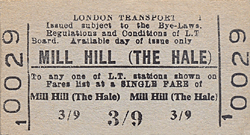 |
The second track between Mill Hill East and The Hale had been lifted in 1941, but the line remained open for freight traffic and remained steam-hauled until December 1961. After that date diesel traction was employed but this was to be short-lived. There was little traffic on the line, and the goods service was withdrawn from 1 June 1964; track-lifting started in |
September
1964.
Despite closure of The Hale in 1939 the booking office at Mill Hill Broadway was still selling tickets from Mill Hill (The Hale) until the late 1960s. These were valid on the 240 bus and differed from ordinary Underground tickets by having the name underlined.
Click here for a light hearted film about the unfinished Northern Line extension.
Tickets from Brian Halford & Michael Stewart. Bradshaw from Chris Totty. B & W street maps from Alan Young. Route map drawn by Alan Young.
Sources:
|

hale_old1.jpg)

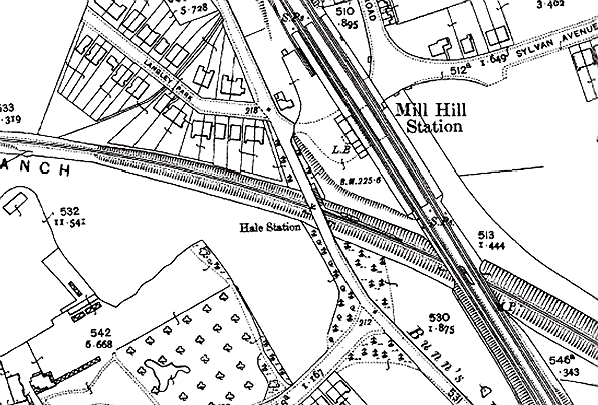
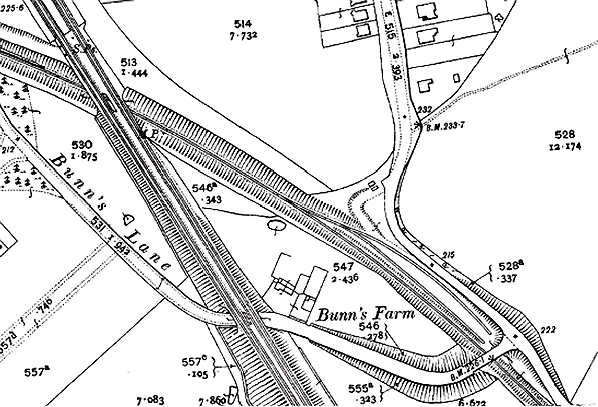

hale_old5.jpg)
hale_old2.jpg)
hale_old3.jpg)
hale_old13.jpg)
hale_old8.jpg)
hale_old9.jpg)
hale_old4.jpg)
hale_old6.jpg)
hale_old15.jpg)
hale11.jpg)
hale6.jpg)
hale1.jpg)
hale17.jpg)













hale3.jpg)

 Home Page
Home Page